Leaf loss and yellow leaves on the rubber tree often indicate incorrect care. Here's what to do if your rubber tree is losing leaves.
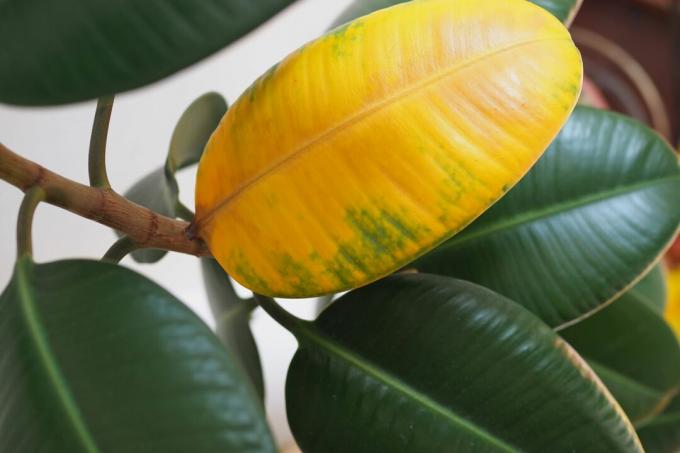
If the beloved rubber tree (Ficus elastica) loses its leaves or the leaves turn yellow, then something is wrong. Then the matter should be investigated in order to save the rubber tree, which is so undemanding overall. With the right measures, you can help your houseplant to have a new and longer life.
contents
-
Rubber tree gets yellow leaves
- Causes of yellow leaves on rubber trees
- Measures against yellow leaves on the rubber tree
-
Rubber tree loses leaves
- Causes of leaf loss in rubber trees
- Measures against leaf loss in rubber trees
Rubber tree gets yellow leaves
Rubber trees are popular as a houseplant in homes or in the office. No wonder, because the tree is considered easy to care for, robust and suitable for beginners. So you can't go wrong with the rubber tree? Unfortunately, it is, because no matter how resilient the plant may be, it will not forgive you for some serious mistakes. If the rubber tree is cared for incorrectly or placed in an unsuitable location, it reacts in an impressive way: the leaves turn yellow or are shed - sometimes even completely. The result isn't particularly pretty, so you should know what caused the loss of hands so you can react accordingly. If you act early enough, the damage is reversible and you can save your gum tree.

Causes of yellow leaves on rubber trees
If the leaves of your rubber tree are turning yellow, there can be various reasons. Often the yellowing - the so-called chlorosis - is only a preliminary stage of dying and then falling leaves.
Possible causes of yellow leaves on the rubber tree:
- Incorrect watering: waterlogging or dryness
- draft
- Unfavorable wintering location: Too cold or too dark
- Incorrect or missing fertilization: lack of nutrients or over-fertilization
- Pest Infestation or Disease: Anthracnose, Xanthomonas, spider mites or thrips are possible pathogens
Tip: The most common care mistake in rubber trees is excessive watering and waterlogging. In addition, the rubber tree does not tolerate drafts and is extremely reluctant to be moved, i.e. relocated. If the soil is too wet and its roots are putrid by too much water, the leaves turn yellow. Another reason for the discoloration of the foliage can be too much draft. Incorrect lighting conditions and magnesium deficiency are also possible causes. If the rubber tree does not have enough magnesium available, it cannot produce enough green leaves and the leaves turn yellowish. But too much nutrients can also lead to yellowing of the leaves.
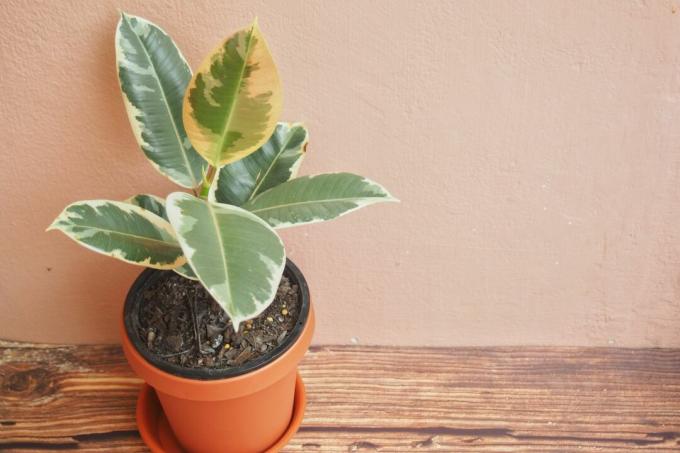
Measures against yellow leaves on the rubber tree
If you react at the first sign of yellowing foliage, you can best help your gum tree. First check the location and humidity. Is it bright enough for its needs? Is there water in the coaster all the time? Is the substrate damp? Do the roots smell rotten and musty? You should first answer these questions before you act.
The rubber tree should be in a bright position, but not in direct sunlight at midday. Too much direct sunlight or lack of light can lead to yellow leaves, especially in winter. But beware: the rubber tree is very reluctant to be moved and can also acknowledge the move with leaf fall.
If the substrate is too wet or even root rot, only immediate repotting in fresh substrate will help. In the future, pay more attention to the moisture of the substrate and water more moderately. In addition, a drainage layer of pebbles, potsherds, or expanded clay should be laid at the bottom of the pot, as this allows excess irrigation water to drain off easily.
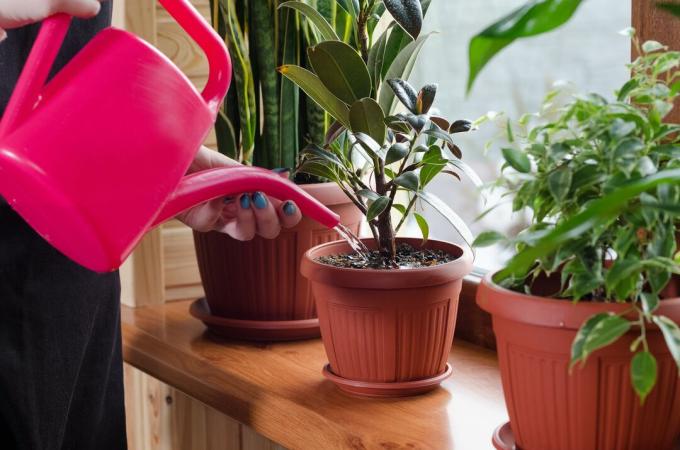
If both the location and the humidity of the tree are right, you can think about whether the fertilization is appropriate for the rubber tree. Nitrogen deficiency, iron deficiency and magnesium deficiency but also sulfur deficiency can lead to yellow leaf chlorosis. If the rubber tree has never been fertilized at all, a liquid fertilizer offers a quick remedy. If chlorosis occurs despite regular fertilization, there could be a lack of a micronutrient - to remedy this, the plant is best repotted directly.
In the future, you should then adjust the fertilization of your plant to prevent future nutrient deficiencies. In addition to the main nutrient elements, primarily organic fertilizers also provide micronutrients and are therefore preferable to mineral fertilizers. A dose of slow-release fertilizer, such as ours Plantura organic universal fertilizer, the rubber tree only needs 1 to 2 times a year.
Attention: Strong over-fertilization with mineral fertilizers also initially leads to yellow foliage and then to leaf fall. So always dose fertilizer carefully or rely directly on mostly organic fertilizers to be on the safe side.
Summary combating yellow leaves on the rubber tree:
- Change of location, especially in the winter quarters, check the temperature and lighting
- Repot in case of root rot, create a drainage layer
- adjust fertilization

Rubber tree loses leaves
If the leaves on the tree not only discolour, but fall off completely, the situation is already more critical. With proper care, the rubber tree usually sprout again, but if the care error persists, the frugal houseplant could also die.
Causes of leaf loss in rubber trees
The causes are the same as for yellow chlorosis on the rubber tree
Possible causes of leaf loss on rubber trees:
- If the care error persists, the leaves will fall after the yellowing
- The loss of leaves occurs particularly quickly in the case of critical over-fertilization and prolonged waterlogging.
- With all other care mistakes, it usually takes longer for the discolored leaves to fall to the ground.
One of the main reasons for rubber tree leaf shedding is improper watering, as both too much and too little water will cause the tree to shed its leaves. Therefore, check the substrate for moisture with your finger and smell the root ball to detect possible root rot. Another possible cause is an incorrect location for the green roommate. Both a location that is too cold and too much draft cause leaf loss.

So after you have tested the moisture of the substrate, you should take a closer look at the location of your rubber tree. Incorrect fertilization is also a care mistake that can have serious consequences. The rubber tree is one of the weak consumers and therefore only needs a few nutrients. Finally, pests can also be the cause of chlorosis and leaf loss. Therefore, examine all parts of the plant and see if you can discover uninvited guests on the rubber tree.
Measures against leaf loss in rubber trees
There are a number of things you can do to prevent leaf loss on the rubber tree.
Preventing leaf loss on the rubber tree:
- Bright location without direct sun
- No draft
- Temperatures of 18-20°C, never below 16°C
- Sufficiently large planter
- Water moderately
- Fertilize little to moderately
- Check the tree regularly for pests
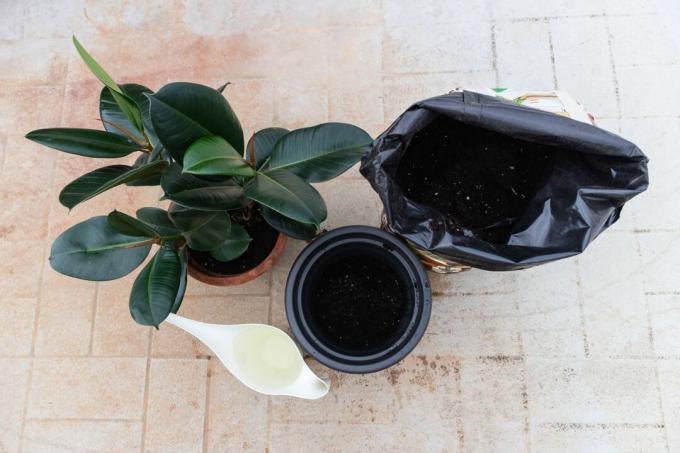
If it is already too late for preventive measures and the tree is already losing leaves, there are still plenty of options that you can use to save your plant.
Wrong location: Change location if conditions in the current location are not ideal for the tree. The rubber tree needs enough space to spread, enough light - even in winter - and temperatures between 18 and 20 °C. The tree does not want to stand at all in draughty places.
Replace old substrate and give the roots more space: You should yours ficus repot every two to three years. At the latest when the entire substrate is rooted, the rubber tree needs a new planter. This can be recognized, for example, by the fact that the roots grow out of the earth at the top or out of the drainage hole at the bottom. For repotting, choose a new container that is only slightly larger than the old one and change the substrate as well.
Substrate too dry: If the substrate in the pot has completely dried out, it is best to dip the entire pot in lukewarm water. It stays here until no more air bubbles rise. This allows the substrate to soak up water. Incidentally, this method is also very suitable for watering the rubber tree normally. Then let the rubber tree drain well.
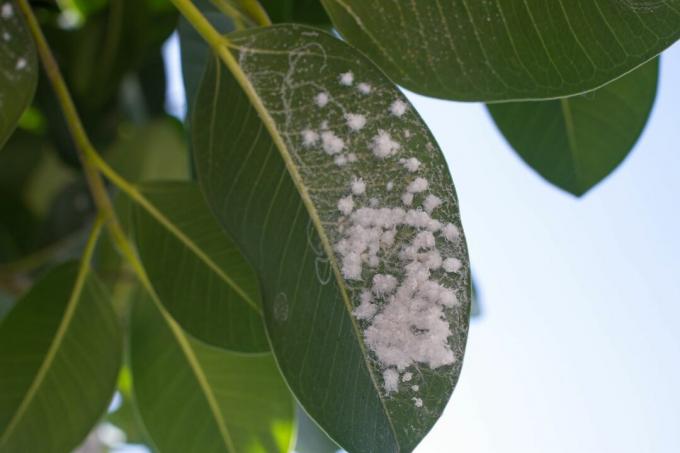
Substrate too wet: If the substrate is too moist, other measures are required. If root rot has already formed, you should cut off the affected root parts with clean pruning shears. After that, the tree is repotted in a new pot with drainage and new substrate. From now on you should only water moderately and only when the top layer of the substrate has dried.
over-fertilization: If the rubber tree has been over-fertilized by the wrong dosage of mineral fertilizer, the bale should first be watered very thoroughly to wash out excess nutrients. The plants can also be saved by immediately removing the earth ball and cutting back heavily. Adjust the fertilization in the future: It is best to use a predominantly organic fertilizer like ours Plantura organic universal fertilizer. A critical over-fertilization is almost impossible with such a fertilizer, as it releases the nutrients contained slowly, piece by piece.
pest infestation: The most common pests on rubber trees are spider mites (Tetranychidae), scale insects (coccoidea) and Mealybug (homoptera). In this case, possible remedies against the unwanted pests are ecological pesticides or beneficial insects. Beneficial insects are natural opponents of the pests, which they like to eat and fight in this way. Help against spider mites, for example predatory mites (Phytoseiulus persimilis). Against scale insects and mealybugs are suitable parasitic wasps (Ichneumonidae) as beneficial insects. But also lacewings, such as ours Plantura lacewings against aphids, thrips and co. can be used against mealybugs, spider mites and other pests. The larvae, which are supplied in a cardboard honeycomb, are simply scattered over the plant and clear results are usually visible after about a week. Even more about exciting beneficials you can read about them in our magazine as natural little helpers.
Summary of measures against leaf loss on rubber trees:
- relocation
- If there is not enough space for the roots, repot into a larger container
- If the substrate is too dry, immerse the whole pot in water
- In case of root rot, repot and create a drainage layer
- In case of over-fertilization, water the bales thoroughly or loosen the soil from the roots and repot
- Treat in case of pest infestation, for example use beneficial insects
notice: In particularly bad cases, it may be that the ficus sheds all its foliage. This is certainly not a pretty sight, but it is also no reason to dispose of the tree right away. With a little care, the tree can recover. A lot of patience is required here. It can take up to three months for the rubber tree to start showing new buds. Pruning now does more harm than good to the tree. It is better to provide the right growing conditions and wait. In order to be able to avoid possible care mistakes in the future, you will find everything about the right one in this article Care of the rubber tree.


